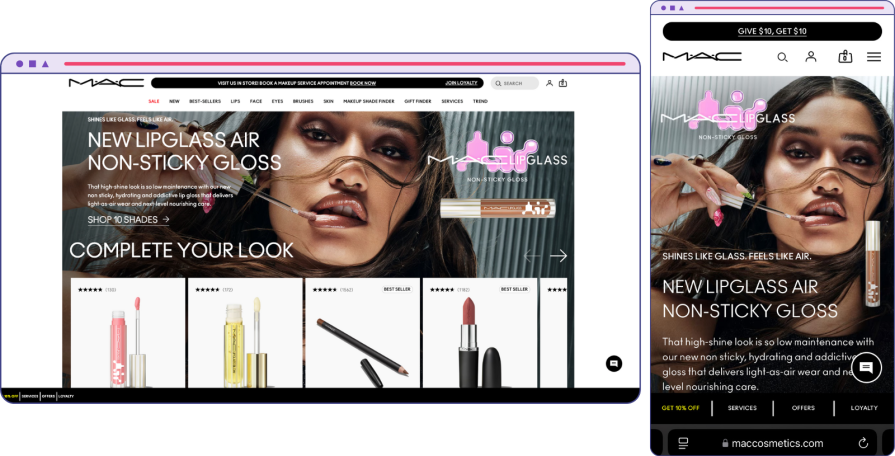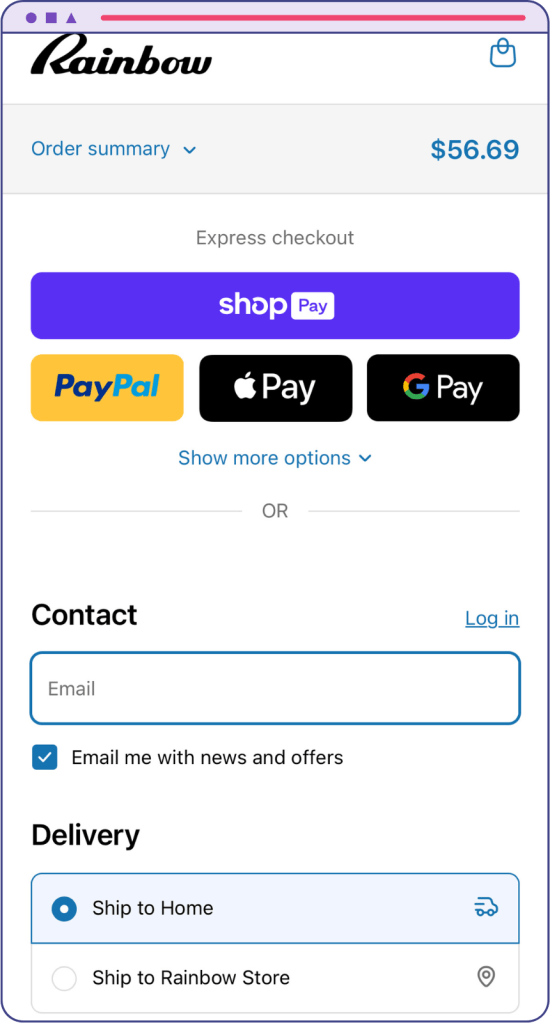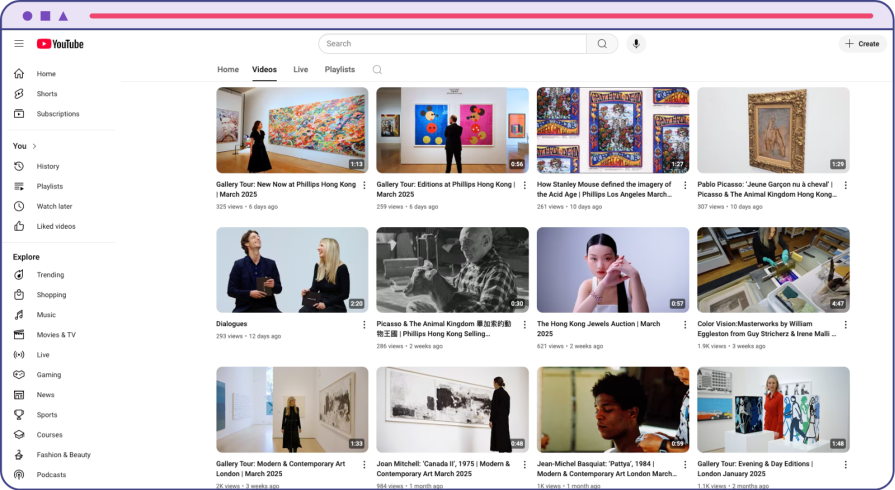If there’s one thing you can say about ecommerce, it’s that the field is always changing. Consumers constantly develop new preferences and respond to developments in the market. Because of this, you need to keep a finger on the pulse of what’s happening, or risk getting left behind by your competitors.

To help you, the following article covers key lessons shared by ecommerce PMs during interviews for LogRocket’s Leader Spotlight series. These include insights for overcoming common challenges, as well as ways to embrace innovative ecommerce strategies.
Prioritize the mobile experience
78 percent of retail traffic happens on a smartphone. That means every pixel takes up valuable real estate on a phone screen.
“I think a good practice is to always review the mobile UX first,” said Victoria Katsarou, Vice President, eCommerce for M.A.C North America, part of Estée Lauder Companies. “In terms of the specific features, the way you prioritize content becomes even more key for mobile because the mobile screen size is a lot smaller:”

Product managers should also consider taking advantage of features available on mobile devices.
“We’re constantly looking to take advantage of some of the new biometric features on mobile devices. Whether it’s Face ID or Touch ID, the ability to not have to type a password in is amazing,” said David Cost, VP of Digital and Ecommerce at Rainbow.
“Same thing for applications like Apple Pay or Google Pay — people don’t have to take a credit card out and type anything in. We’re always looking for ways to complete processes on mobile to reduce user friction:”

Another area that Rainbow explores is push notifications. Personalizing push notifications can improve reaction rates by 400 percent. For Cost, push notifications are a valuable way to stand out in a crowded messaging environment.
“We try very hard to not abuse that relationship and work to inject it with enough entertainment value that people don’t feel inclined to turn it off,” said Cost.
Replicating an in-person experience to online
One of the biggest struggles PMs have with ecommerce is providing a real-life experience in a virtual world. Let’s take a look at a couple of examples of companies that managed to do it successfully.
Clothing store
Something as simple as putting a shirt on a mannequin can increase sales for that shirt. Mannequins don’t need additional promotions — people could see the context and apply it to themselves.
Mikal Lewis, Digital Product Management at Whole Foods Market, recalls how his former employer, Nordstrom, had to think about how it could help people have this experience online.
The solution was to provide pictures of the product in varying outfits — people could see the same shirt in different scenarios, like a casual versus formal setting. “Not everyone has the fashion confidence to trust their own perspective, but something as simple as seeing a product in a relatable context — like with a pair of jeans or a jacket similar to one they might own — inspired people to add it to their collections,” said Lewis in his recent Leader Spotlight interview with LogRocket:

Product imagery is crucial, according to Lewis: “We shoot a lot of product videos these days to give customers a full perspective of what they might buy. ”
Auction house
An auction house is filled with buzz from the auctioneer’s rapid-fire speech and a flurry of paddles being raised to place a bid. It might not seem feasible to move this environment to the digital world, but that’s exactly what Phillips did.
“If you go into a gallery in New York, the in-person experience and branding carry over into what we offer on responsive web and our iOS app,” said Elizabeth Van Bergen, Lead Experience Product Manager at Phillips.
“When the pandemic happened, we couldn’t have people visiting the gallery to experience paintings, jewelry, or other art in person. But, it’s really important to see the facets of a diamond, the paint strokes, or where bronze has aged on a piece.”
Van Bergen explained their customers had to experience the work even if they couldn’t be in front of it. One of the features they launched was detailed, high-resolution videos of all their works:

“Whether it’s flat art or a 3D sculpture, we want to focus on the user experience regardless of whether you’re viewing it on an iPad, at your desk, or on your phone,” said Van Bergen.
Multiple delivery options are a game-changer for revenue
“If you’re a brand that’s not already playing with dynamic delivery offerings and pricing, you’re likely leaving incremental revenue on the table,” said Erica Randerson, Vice President of ecommerce at Edible.
Randerson shares that Edible conducted tests to discover what delivery options and pricing users found engaging. Eventually, they released a one-hour delivery option. Edible found that one-hour delivery drove a nine-figure revenue impact within the first few months of launching:

“As a retailer, you may not be able to offer as fast as a one-hour delivery like Edible, but would it be possible to offer next-day delivery or even same-day delivery alongside your more standard options? Providing more options enables the customer to customize their delivery experience,” suggested Randerson.
Fast shipping isn’t your only option though. Randerson found that adding the option to buy online and pick it up at the store drove revenue. “This was something we thought maybe 10 percent of our customers would use, but on some days, it’s almost one-third.”
Get feedback from the people working directly with your customers
Feedback loops can be surprising, yet valuable, for your ecommerce company.
In the same Leader Spotlight interview, Randerson also shared that their stores provided feedback that many customers called asking for help to write the greeting card attached to the gift. This signaled that customers were missing something in their digital experience. “I’m unsure if we would have discovered that if we had simply looked at quantitative data alone,” said Randerson.
With a little help from AI, Edible introduced a new feature to help write messages to loved ones:

“We can now produce a card message on the customer’s behalf if they’d like to choose that option — empowering them to write the perfect message for their wife’s birthday,” shared Randerson.
“…it had over 3,000 interactions in the initial rollout period alone. It’s incredible how qualitative feedback loops with customers can uncover unexpected CRO wins.”
Brad Power, Senior Director of Digital Product & User Experience at Kendra Scott, emphasizes the importance of visiting your physical stores when possible.
“It’s great to have a retail person sit down and help you think through how new features may impact their store in a way that you might not have thought. I’d recommend doing that quarterly to start,” suggested Power.
Power also talks about having multiple and regular customer signals. From these, you can learn what your customers need and how to align it with your strategic initiatives. Everything from going to the store to talk to customers to sending post-purchase survey emails can make a difference.
In fact, Kendra Scott’s patented Color Bar was born from customer interactions. People wanted to customize their jewelry, and employees were manually bending prongs to replace stones. Kendra Scott saw this demand and built a way for people to choose their stones and other settings for their jewelry. It’s a highly personalized and scalable experience that benefits customers and the company.
Keep the checkout process smooth
You don’t want users to get distracted and leave in the middle of checkout. Make sure the user knows what action to take next.
Katsarou also stresses the importance of making sure coupon codes are working. Sometimes codes don’t apply to certain products or don’t function when there’s another offer available.
“Clarifying these things is important because oftentimes the person would have checked out anyway, at times even without an offer, but because they see an advertised offer or program doesn’t apply to them and they don’t understand the reasoning, they get turned off,” she says.
Heatmaps and session tools are great ways to monitor the checkout process. You can see exactly how users are interacting with your site.
Key takeaways
Ecommerce is constantly changing. It’s a challenge to adapt to consumers’ changing preferences, habits, and expectations. Meeting this challenge requires you to constantly gather data, fix errors, and try to spot emerging trends.
Holding regular conversations helps you make better decisions. Whether it’s talking to sales reps, data analysts, or customers, their stories have a meaningful impact on the product that you build. With a customer-centric mindset, you can create an online presence that’s just as meaningful as an in-person interaction.
Featured image source: IconScout
The post 5 lessons learned from ecommerce product managers appeared first on LogRocket Blog.